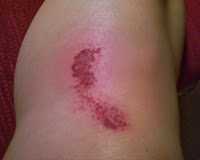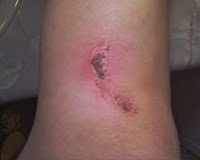How to Make a Magical Wound Spritz
One morning in mid-October, I jumped off my treadmill in the middle of my workout to try to grab a small piece of rawhide bone—a potential choking hazard—from one of my dogs before she could swallow it. Because it was early morning and I was tired and distracted, I forgot all about the proper way to get back on the moving treadbelt. I just jumped right back on it, and the treadmill immediately showed me who was boss! I fell on the treadbelt and scraped up my left leg and right knee. It was very painful at the time.
I had an appointment with Cynthia McMullen a few days after my fall. She has been my massage therapist/??healer for more than a year now, and I’ve also been attending her Essential Oil workshops for the past year. I am fascinated and impressed by Cynthia’s ability to create magic healing potions to address all kinds of health issues. She is a master alchemist who works in harmony with Mother Nature.
After I showed Cynthia my injuries, she decided to create a Wound Spritz (a hydrosol-essential oil blend) to protect them from infection and help them heal more quickly and to also help alleviate pain. She selected three Oshadhi brand hydrosols (Yarrow, Helichrysum, and Witch Hazel) and three essential oils (Ginger, Helichrysum, and White Champa Leaf) and placed them on a stool in front of me so I could watch her wizardry. She also set out a bottle of pure liquid Aloe and a small, 2oz. brown glass bottle to hold the concoction.
Cynthia explained why she selected each ingredient for the formula:
HYDROSOLS
· Yarrow – It’s anti-inflammatory, and it will help heal wounds and anything that’s bleeding.
· Helichrysum – It’s the “go to” choice for healing bruises and wounds.
· Witch Hazel – It’s somewhat antiseptic for wounds and also really nice on the skin.
ESSENTIAL OILS
· Ginger – It helps with pain and is very nurturing.
· Helichrysum – In this blend, the essential oil will help support the wound-healing aspect of the Helichrysum hydrosol.
· White Champa Leaf – It’s a more spiritual oil, and it will help provide insights around the emotions involved.
ALOE VERA
· Aloe – The liquid Aloe Cynthia used came in an Oshadhi hydrosol bottle, but she explained that it’s not a hydrosol. She included it because it’s very soothing to the skin.
Cynthia wanted the Wound Spritz to be concentrated and more potent to help heal the injuries, so she didn’t dilute the formula with water. She combined equal amounts of each of the three hydrosols in the brown bottle, leaving about half an inch of empty space at the top. Then she added the Aloe and the three essential oils. Here’s the formula:
WOUND SPRITZ FORMULA
Yarrow (hydrosol) – 33%
Helichrysum (hydrosol) – 33%
Witch Hazel (hydrosol) – 33%
Ginger (essential oil) – 6 drops
Helichrysum (essential oil) – 2 drops (Cynthia used less of this because it’s supporting the hydrosol.)
White Champa Leaf (essential oil) – 4 drops
Aloe (pure liquid) – 10 drops
I was instructed to always shake the bottle really well to thoroughly blend the oils and water-based hydrosols before using the spray.
Cynthia spritzed my wounds during the session, and the smell was very strong. It didn’t affect her, but it made me cough a little. Although inhaling it isn’t harmful, I made a point of trying not to breathe it in when I used it at home. Cynthia said that the Ginger essential oil was causing my coughing and that if she were to make the formula again, she would only add 2 drops of that instead of 6 drops. Another option to cut back on the intensity of the smell would be to pour some of the blend on a cotton ball and simply dab it on the wounded area.
I ended up spritzing my wounds two or three times a day and taking photos each night to document the healing process. I typically bruise easily (although the bruising sets in gradually), and both bruises and wounds on my legs tend to heal very slowly. This time, however, no additional bruising set in, and the healing process was noticeably faster.
The largest scrape on my left leg was a little swollen when Cynthia first sprayed it, and the swelling was gone that same night. By the end of the second day, that same scrape was drier and looked more like a scab. There was redness around all of the wounds that did not increase over time, and the wounds themselves began to dry up more and more and shrink a little with each ensuing day. By the fifth day, the largest scabs on my left leg and right knee had shrunk substantially. By the seventh day, they looked even better. The photos below document these healing results.
VARIATIONS
During my session, Cynthia described her thought process for determining which of the ingredients from Mother Earth to use in a new blend. She begins by asking herself, “What do I have on hand? And out of what I have on hand, what would work really well for the situation?” She explained that she could have made a variation on the Wound Spritz with half of the ingredients that she ended up using. “If I just had two of the hydrosols, I could still do quite a bit with those. Even if I just had one, I could still do quite a bit with it,” she said. After selecting the hydrosols, she then looks at which essential oils would enhance the blend.
Cynthia said that another variation on the Wound Spritz could be made with just the three hydrosols, if someone only had those on hand. She explained that the essential oils make the spritz stronger and shape the overall feel of the blend, but it would still be effective with just the hydrosols. This option (without the essential oils) would even be safe for use on children and pets. Cynthia cautioned, however, that for use on children or puppies less than 1 year old, the hydrosol blend should be diluted with 50% purified water.
STORAGE
If the Wound Spritz will be used on a short-term, regular basis, it doesn’t need to be refrigerated but should be kept out of direct sunlight and heat. If it will be used sparingly and stored indefinitely, then it should be refrigerated. Cynthia said that it will be good for about nine months to one year.


